
Fraxinus, commonly called ash, is a genus of flowering plants in the olive and lilac family, Oleaceae. It contains 45–65 species of usually medium to large trees, mostly deciduous, though a number of subtropical species are evergreen. The genus is widespread across much of Europe, Asia, and North America.

Fraxinus americana, the white ash or American ash, is a species of ash tree native to eastern and central North America.

The Victoria and Albert Museum in London is the world's largest museum of applied arts, decorative arts, and design, housing a permanent collection of over 2.27 million objects. It was founded in 1852 and named after Queen Victoria and Prince Albert.

Bookworm is a general name for any insect that is said to bore through books.

A woodworm is the wood-eating larva of many species of beetle. It is also a generic description given to the infestation of a wooden item by these larvae.

Buprestidae is a family of beetles known as jewel beetles or metallic wood-boring beetles because of their glossy iridescent colors. Larvae of this family are known as flatheaded borers. The family is among the largest of the beetles, with some 15,500 species known in 775 genera. In addition, almost 100 fossil species have been described.

The emerald ash borer, also known by the acronym EAB, is a green buprestid or jewel beetle native to north-eastern Asia that feeds on ash species. Females lay eggs in bark crevices on ash trees, and larvae feed underneath the bark of ash trees to emerge as adults in one to two years. In its native range, it is typically found at low densities and does not cause significant damage to trees native to the area. Outside its native range, it is an invasive species and is highly destructive to ash trees native to Europe and North America. Before it was found in North America, very little was known about emerald ash borer in its native range; this has resulted in much of the research on its biology being focused in North America. Local governments in North America are attempting to control it by monitoring its spread, diversifying tree species, and through the use of insecticides and biological control.

Frass refers loosely to the more or less solid excreta of insects, and to certain other related matter.

Fraxinus pennsylvanica, the green ash or red ash, is a species of ash native to eastern and central North America, from Nova Scotia west to southeastern Alberta and eastern Colorado, south to northern Florida, and southwest to Oklahoma and eastern Texas. It has spread and become naturalized in much of the western United States and also in Europe from Spain to Russia.
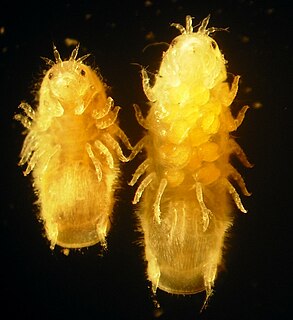
A gribble /ˈgɹɪbəl/ is any of about 56 species of marine isopod from the family Limnoriidae. They are mostly pale white and small crustaceans, although Limnoria stephenseni from subantarctic waters can reach 10 mm (0.4 in).

The common furniture beetle or common house borer is a woodboring beetle originally from Europe but now distributed worldwide. In the larval stage it bores in wood and feeds upon it. Adult Anobium punctatum measure 2.7–4.5 millimetres (0.11–0.18 in) in length. They have brown ellipsoidal bodies with a prothorax resembling a monk's cowl.

Fraxinus nigra, the black ash, is a species of ash native to much of eastern Canada and the northeastern United States, from western Newfoundland west to southeastern Manitoba, and south to Illinois and northern Virginia. Formerly abundant, as of 2014 the species is threatened with near total extirpation throughout its range, as a result of infestation by a parasitic insect known as the emerald ash borer.

The term woodboring beetle encompasses many species and families of beetles whose larval or adult forms eat and destroy wood. In the woodworking industry, larval stages of some are sometimes referred to as woodworms. The three most species-rich families of woodboring beetles are longhorn beetles, bark beetles and weevils, and metallic flat-headed borers. Woodboring is thought to be the ancestral ecology of beetles, and bores made by beetles in fossil wood extend back to the earliest fossil record of beetles in the Early Permian (Asselian), around 295-300 million years ago.

Hylotrupes is a monotypic genus of woodboring beetles in the family Cerambycidae, the longhorn beetles. The sole species, Hylotrupes bajulus, is known by several common names, including house longhorn beetle, old house borer, and European house borer. In South Africa it also is known as the Italian beetle because of infested packing cases that had come from Italy. Hylotrupes is the only genus in the tribe Hylotrupini
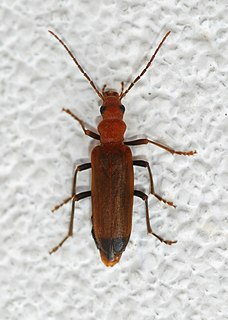
The wharf borer, Nacerdes melanura, belongs to the insect order Coleoptera, the beetles. They belong to the family Oedemeridae, which are commonly known as false blister beetles. Wharf borers are present in all the states of the USA except for Florida. It takes about a year to develop from an egg to an adult. The insect is called the 'wharf borer' because the larval stage of this insect is often found on pilings and timbers of wharves, especially along coastal areas. The adult beetles can be identified via a black band across the end of both elytra, or wing covers. In addition, wharf borers can be distinguished from other members of the family Oedemeridae via the presence of a single spur on the tibia of the forelegs, and the distance between both eyes. Eggs are oviposited on rotten wood where larvae hatch and burrow to feed on rotten wood. Adults do not feed and depend on stored energy reserves accumulated during the larval stage. They are considered to be a pest because they damage wood used in building infrastructures.

An increment borer is a specialized tool used to extract a section of wood tissue from a living tree with relatively minor injury to the plant itself. The tool consists of a handle, an auger bit and a small, half circular metal tray that fits into the auger bit; the last is usually manufactured from carbide steel. It is most often used by foresters, researchers and scientists to determine the age of a tree. This science is also called dendrochronology. The operation enables the user to count the rings in the core sample, to reveal the age of the tree being examined and its growth rate. After use the tool breaks down: auger bit and extractor fit within the handle, making it highly compact and easy to carry.
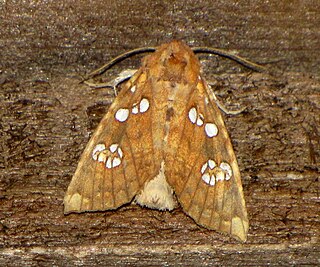
Papaipema is a genus of moths of the family Noctuidae. The genus was erected by John B. Smith in 1899.
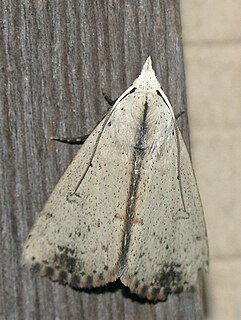
Scolecocampa liburna, the dead-wood borer, is a moth in the family Erebidae. The species was first described by Carl Geyer in 1837. It is found in the US from southern Wisconsin and Michigan to central New England south to Florida and Texas.
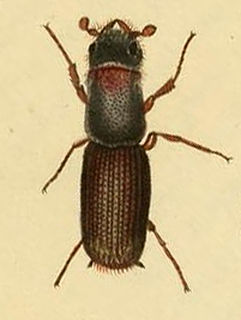
Platypus is a weevil genus in the subfamily Platypodinae.

Piling foundations support many historic structures such as canneries, wharves, and shore buildings. The old pilings present challenging problems during restoration as they age and are destroyed by organisms and decay. Replacing the foundation entirely is possible but expensive. Regularly inspecting and maintaining timber piles may extend the life of the foundation.




















